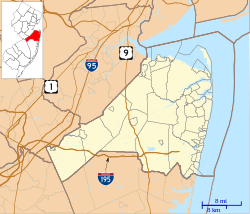Holmdel Horn Antenna

The Holmdel Horn Antenna in use in 1962
|
|
| Location(s) |
Holmdel Township, New Jersey |
|---|---|
| Named after |
Holmdel Township, New Jersey |
| Coordinates | 40°23′26″N 74°11′05″W / 40.39069°N 74.18486°WCoordinates: 40°23′26″N 74°11′05″W / 40.39069°N 74.18486°W |
| First light | 1959 |
| Telescope style |
radio telescope, horn antenna |
| Diameter | 20 ft (6.1 m) |
|
Holmdel Horn Antenna
|
|
| Location | Holmdel Road, Holmdel Township, New Jersey |
| Built | 1959 |
| Architect | A.B. Crawford |
| NRHP Reference # | 89002457 |
| Significant dates | |
| Added to NRHP | December 20, 1989 |
| Designated NHL | December 20, 1989 |
|
|
|
|
[]
|
|
The Holmdel Horn Antenna is a large microwave horn antenna that was used as a radio telescope during the 1960s at Bell Telephone Laboratories in Holmdel Township, Monmouth County, New Jersey, United States. It was designated a National Historic Landmark in 1988 because of its association with the research work of two radio astronomers, Arno Penzias and Robert Wilson. In 1965 while using this antenna, Penzias and Wilson discovered the microwave background radiation that permeates the universe. This was one of the most important discoveries in physical cosmology since Edwin Hubble demonstrated in the 1920s that the universe was expanding. It provided the evidence that confirmed George Gamow's and Abbe Georges Lemaitre's "Big Bang" theory of the creation of the universe. This helped change the science of cosmology, the study of the history of the universe, from a field for unlimited theoretical speculation into a discipline of direct observation. In 1978 Penzias and Wilson received the Nobel Prize for Physics for their discovery.
The horn antenna at Bell Telephone Laboratories in Holmdel, New Jersey, was constructed in 1959 to support Project Echo—the National Aeronautics and Space Administration's passive communications satellites, which used large Earth orbiting aluminized plastic balloons as reflectors to bounce radio signals from one point on the Earth to another.
...
Wikipedia



